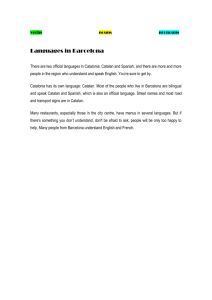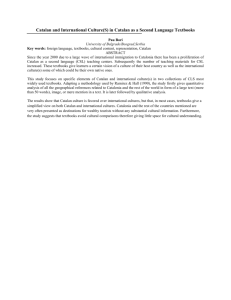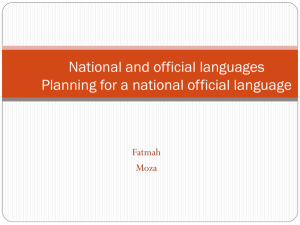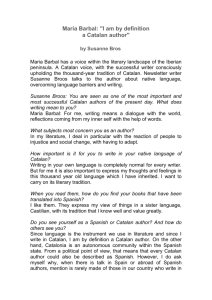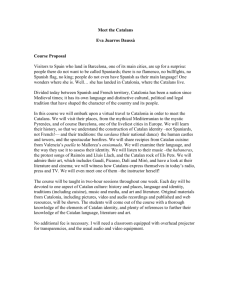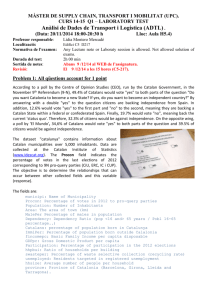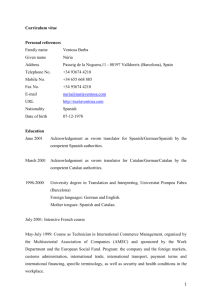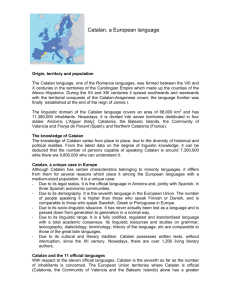Title Page
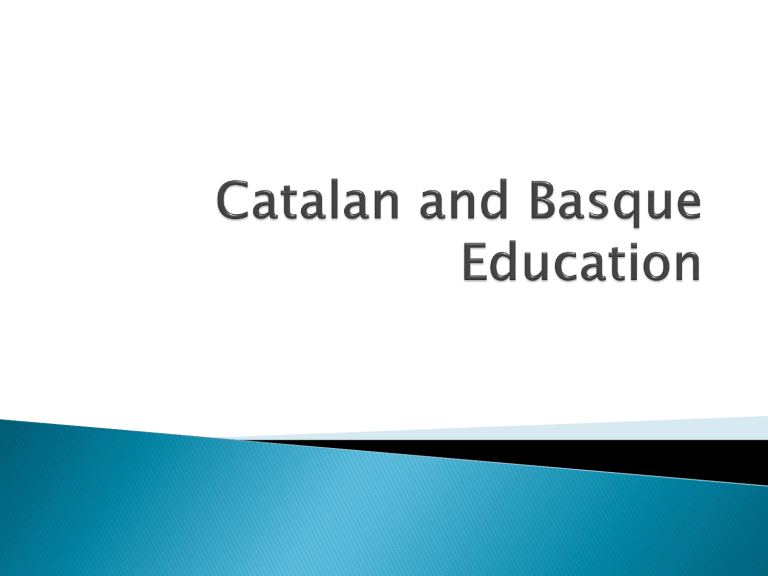
Catalan banned from education C 17 th -20 th imposition of Spanish in obligatory education education important for vitality of a language
C 20 th – political Catalanism:
◦ Mancomunicat, Generalitat
1932 Statute of Catalonia – Catalan in education for first time
Franco dictatorship – prohibition of Catalan democratic transition – Catalan a subject
Estatuts d’Autonomia
and linguistics laws put emphasis on the learning and education use of
Catalan unitary linguistic model:
model de conjunció
1.
2.
3.
4.
5.
Totes les persones tenen dret a rebre l’ensenyament en català, d’acord amb el que estableix aquest Estatut. El català s’ha d’utilitzar normalment com a llengua vehicular i d’aprenentatge en l’ensenyament universitari i en el no universitari.
Els alumnes tenen dret a rebre l’ensenyament en català en l’ensenyament no universitari. També tenen el dret i el deure de conèixer amb suficiència oral i escrita el català i el castellà en finalitzar l’ensenyament obligatori, sigui quina sigui llur llengua habitual en incorporar-se a l’ensenyament. L’ensenyament del català i el castellà ha de tenir una presència adequada en els plans d’estudis.
Els alumnes tenen dret a no ésser separats en centres ni en grups classe diferents per raó de llur llengua habitual .
Els alumnes que s’incorporen més tard de l’edat corresponent al sistema escolar de Catalunya gaudeixen del dret a rebre un suport lingüístic especial si la manca de comprensió els dificulta seguir amb normalitat l’ensenyament.
El professorat i l’alumnat dels centres universitaris tenen dret a expressarse , oralment i per escrit, en la llengua oficial que elegeixin .
children are entitled to receive primary education in their language of habitual use – Catalan or
Spanish
(Article 21.2 LPL 1998) it is compulsory to teach both languages at all levels of non-university education all children in Catalunya should be able to use
Catalan and Spanish normally and correctly by the end of primary education
(Article 21.2 LPL 1998)
Catalan is the main teaching language and a compulsory subject:
◦ pre-primary education 87% of pupils taught mainly in Catalan
◦ primary education 69% of pupils taught mainly in
Catalan (1992-93)
Catalan is the main teaching language for:
◦ 73% of pupils in public-sector schools
◦ 74% of pupils in private schools
a compulsory subject in all schools use of Catalan has increased in recent years
◦ wider range of textbooks in Catalan
◦ still a low number of university textbooks
◦ most of books used are in Spanish/English
Catalan is the main teaching language for
31% of pupils most of the remainder were all taught partly in Catalan all pupils take Catalan as a subject
everyone entitled to express themselves in the official language of their choice
(Article
22.1 LPL 1998)
between 1990-93 the use of Catalan for university entrance tests went from 52-59%
% of classes in Catalan (Department of
Universities of Catalonia):
University of Barcelona 66% Rovira I Virgili University 65%
Autonomous Uni of Barcelona 62% Open University of Catalunya 71%
Polytechnic Uni of Catalunya 59% Ramon Llull University 76%
Pompeu Fabra University
Girona University
Lleida University
66% Vic University 84%
80% International Uni of Catalunya 44%
53% Abbot Oliba-CEU University 32%
responsibility of the
Generalitat de Catalunya
Catalan and Spanish teaching is compulsory
(Article 23.1 LPL 1998)
linguistic issue (la Llei de normalització lingüística , 1983) -> language policy more political (La Llei de política lingüística ) efficient use of Catalan has gone from strength to strength tension between the is increasing
Generalitat and the Spanish government
02/09/11 Tribunal Superior de Justicia de Cataluña gave
Generalitat two months to make Spanish a vehicular language in Catalan education system huge oppression and the Generalitat maintained that this ruling would lead to the disintegration of society demands were unclear as Catalunya was already obeying the law, ensuring that all pupils are fully competent in Spanish upon leaving school
Generalitat didn’t see that it was necessary to make any additional changes
Valencia
Generalitat Valenciana has full power over the education system
Official policy: ‘support the introduction of Catalan as a teaching language in schools and to establish language immersion programmes for Spanish-speaking pupils’ http://www.uoc.edu/euromosaic/web/document/catala/an/i2/i2
.html#3.1
La Llengua Valenciana is the traditional and official name of the
Catalan language in Valencia.
‘The Valencians, who have been keen to establish their different identity from the Catalans, insisted that there should be a
Valencian version of the 1978 Constitution. This was granted, with the result that a document was published which, almost without exception, was word for word identical to the Catalan version!’ (Mar-Molinero: 1997)
Llei d'Ùs i Ensenyament del Valencià (Law of use and teaching of
Valencian/Catalan): both Catalan and Castilian are compulsory subjects to be studied in all levels of education except at university
Since 1983, Catalan has been used more and more as a medium for teaching
Catalan is the main teaching language in some schools and a compulsory taught subject in all schools.
1983: 10 schools that taught entirely or partially in
Catalan
1992: 392 schools that taught entirely or partially in
Catalan
1991: decree made it compulsory for all schools to provide a minimum number of classes in both Catalan and Castilian from the age of 8.
Criticisms and exemptions
Immersion programmes for pupils who only speak
Castilian
Progress has been slow in areas when Castilian is the dominant language
The use of Catalan has increased significantly
Catalan is now a compulsory taught subject in all schools
Academic year 1983-1984: 1280 pupils taught at least partially in Catalan
1993-1994: increased to 7900
There are 4 main public universities in the
Community of Valencia: James I University, Miguel
Hernandez University of Elche, Polytechnic
University of Valencia and the University of
Valencia.
Use of Catalan is below 10%
Used mainly as a language of social interaction rather than a medium for teaching
Language training programme in place for adults who want to learn Catalan
Many materials are available to assist
1986: regional government set up the Junta Avaluadora de
Valencià which organised official exams in Catalan for adult learners on the language programme.
The 4 main islands are: Majorca, Minorca, Ibiza and Formentera. The capital is Palma (de Majorca)
The central government has the responsibility of education, but the
Balearic government has power of the teaching of Catalan.
Language Standardisation Law of 1986:
Catalan is the official language of all levels of education
Pupils have the right to be taught in their ‘own’ language
Catalan language and literature is compulsory at all levels except at university
By the end of compulsory education, pupils must be able to use both
Castilian and Catalan ‘normally and correctly’
Students and lecturers at university have the right to use the language of their choice
Catalan as a medium of teaching: usually parents / teachers who initiate this http://www.uoc.edu/euromosaic/web/document/catala/an/i3/i3.html#
3.1
1990-1991: 147 out of 555 schools taught classes partially in Catalan
Catalan is currently a compulsory subject in all schools.
1990-1991: 48% of public-sector schools provided teaching at least partially in Catalan.
Catalan is a compulsory subject taught in all schools.
According to the Universitat Oberta de Catalunya, around 60% of pupils are taught at least partially in
Catalan.
According to the Universitat Oberta de Catalunya, around 50% of the courses taught at the Universitat de les Illes Balears are taught in Catalan
Variation between departments
Catalan as a subject in its own right
Large number of Catalan language courses are available to the public.
1991: around 6000 people registered on one of these courses.
3 main problems identified by Hoffman
Lack of confidence of many non-native Catalan teachers
Demographic distribution of children from Catalanspeaking homes and Castilian speaking ones is uneven
Many children from middle-class Catalan families go to private schools making the proportion of Catalan to
Castilian speaking children in state schools even more unfavourable.
‘…The aim in education is to have a wholly Catalan system where Castilian is taught as a foreign language.’
(Hoffman 2000)
‘It’s promotion in the public sphere, in education and the media has resulted in an increase in the number of those who read it, speak it and write it, up by some 20% in the period between the 1986 and 1996 census.’
(Hoffman: 2000)
The Catalan-speaking area of France (known as Catalunya Nord ) covers the Département de
Pyrénées Orientales
The geographical variant of Catalan spoken in
France has traditionally been known as northern Catalan or
Roussillonnais
Linguistic legislations very recent in the languages history
Northern Catalonia annexed in 1659 after
Treaty of the Pyreenes
Harsh repression followed
‘Gallicisation’ from 1682
Édit du Roi in 1700
Languedoc-Roussillon:
2.3 million people
140,000 speakers
6% of population speak Catalan
(
French is used in administration and public services
Bilingual place names
Bilingual street names from 1993 in Perpignan
Dans le nord de la Catalogne cependant, les chiffres montrent une baisse dans la connaissance de la langue, et seulement 34 % peuvent parler le catalan, 27 % peuvent l'écrire et 55 % peuvent le comprendre. En catalan, on
écrit
català
pour désigner la langue catalane
llengua catalana
).
Federació per a la Defensa de la Llengua i de la Cultura Catalanes
Institut Rossellonès d'Estudis Catalans (GREC)
Universitat Catalana d'Estiu
(1969)
Ómnium Cultural Catalunya-Nord
Federació Sardanista
Centre de Documentació i Animació de la
Cultura Catalana
Dexionne Law in 1951
Haby Law in 1975
Bas-Lauriol Law in 1975
Toubon Law in 1994
21 st July 2008 – article 75-1 added to the
French constitution
Previous articles discuss the ex-colonies / and the status of those people
Article 75-1: Les langues régionales appartiennent au patrimoine de la France
«Regional languages are part of France’s heritage»
Préambule:
The promotion of the Catalan language will not be detrimental to the French language.
La politique de promotion de la langue catalane ne se fait pas au détriment de la langue française.
The linguistic policy in favour of Catalan is based on inclination and encouragement and not on obligation.
La politique linguistique en faveur du catalan est fondée sur l'incitation et l'encouragement et non sur l'obligation[…]
ARTICLE 1:
Le Conseil Général des Pyrénées-Orientales reconnaît officiellement, au côté de la langue française, le catalan comme langue du département.
The Conseil Général des Pyrénées-Orientales officially recognises Catalan, alongside the
French language as a language within the département.
ARTICLE 4:
De manière générale, toutes les structures départementales (services, administrations, organismes associés et partenaires) intégrent la dimension de la langue catalane dans leurs fonctions et attributions, en particulier en ce qui concerne la communication avec le public et la signalisation
In general, all regional structures will integrate the Catalan language in their functions, particularly concerning communication with the public.
ARTICLE 7:
La langue catalane ne se limite pas à une discipline scolaire. Sa présence à tous les niveaux de la vie publique et sociale doit être garantie et encouragée.
The Catalan language will not be limited to schooling. Its presence at all levels of public and social life must be guarantied and encouraged.
Charter in favour of Catalan in relation to education: aide à l'ouverture de classes bilingues
Help to create bilingual classes généralisation de la sensibilisation à tous les enfants
Spreading the knowledge to all children aide au développement de la formation pour adultes
Help to develop adult education
CEDACC - courses at pre-school level and in primary schools (1000 pupils in 1993-94).
In State nursery and primary education (age
3-11), there is an introductory class in
Catalan language and culture (one and a half hours per week) which is currently attended by 28% of pupils
Education in Catalan through immersion technique
From primary to secondary school
Aims to have completely bilingual students in school and social life
1993 – Catalan schools recognised within
France as private schools
In 2003 – secondary school started, across the board had 500 pupils
12% of pupils (11-15) attend a weekly one hour class of Catalan
Catalan language and culture is also taught
(three hours per week) in general secondary education – however these are only attended by 4% of students
There are also vocational centers offering classes – which the local council half fund
Institut Franco-catalá at University of
Perpignan
Université de Perpignan – Catalan degree since 1982
Masters since 1984
Post-Grad diploma since 1984
ERASMUS with Catalan speaking Universities since 1987
Some other French Universities offer Catalan courses, e.g. Aix-en-Provence, Marsailles,
Paris
CEDACC - Catalan and language consultation service and organising Catalan classes for municipal employees and adult education classes
Granted the status of Nationality within Spain in the Spanish
Constitution of 1978.
Spanish and Basque are coofficial but only Spanish is compulsory.
Guipuzkoa is the most Basquespeaking territory and Alava the less.
Basque Legislation (Ley
10/1992)
European Charter for regional or minority languages (Basque,
June 1992).
Process of linguistic normalisation initiated 20 years ago.
After the death of Franco, entirely education in
Basque became available.
Importance of schools)
Ikastolak
Teaching Models:
(primary and secondary
◦ A : education is entirely in Spanish, with Basque as a compulsory subject.
◦ B: education is partly in Basque and partly in Spanish
◦ D: education is entirely in Basque, with Spanish as a compulsory subject.
◦ X: education is entirely in Spanish (foreigners).
“La Constitución y el Estatuto de Autonomía confían a los poderes públicos de la Comunidad Autónoma Vasca la adopción de las medidas encaminada a asegurar el desarrollo y la normalización del uso del euskera considerando su doble dimensión de parte fundamental del Patrimonio Cultural del Pueblo Vasco y, junto con el castellano, idioma de uso oficial en el Territorio de la
Comunidad Autónoma”.
“Se reconoce el derecho de todo alumno a recibir la enseñanza en euskera, regulándose la obligatoriedad de la enseñanza de la lengua oficial no elegida.”
“Se atribuye al Gobierno la regulación de modelos lingüísticos a impartir, la adopción de medidas encaminadas a la adquisición de un conocimiento suficiente de ambas lenguas oficiales y la adecuación de los planes de estudio.”
“En cuanto a formación del profesorado se prevé la adaptación de sus planes de estudio para conseguir su total capacitación en euskera y castellano”
(Ley 10/1982, de 24 de Noviembre, básica de normalización del uso del Euskera: http://www.parlamento.euskadi.net/pdfdocs/leyes/ley19820010_f_cas.html
)
Signed by “Comite de Ministros del Consejo de Europa” in
June 1992.
Objective of the Charter: “Ofrecer un estatus juridico a las lenguas regionales y minoritarias que permita su uso publico y privado al objeto de lograr su preservacion”.
Education (Article 8)
◦ Nursery education
◦ Primary School
◦ Secondary School
◦ Professional and technical teaching
◦ University
◦ Education for adults
◦ Culture and History teaching
◦ Qualification of the teachers
◦ Formation of control entities.
Private education (51%)
In the Basque Autonomous Region (BAR), out of 1,851,000 inhabitants, 558,000 (30%) speak Basque well, 340,000 (18%) a little and 953,000 (52%) not at all.
Process of linguistic normalisation initiated 20 years ago:
6/10 young people know the Basque language nowadays.
During the last 25 years Euskera has gained 300.000 speakers in BAR.
IV Mapa Sociolinguistico: http://www.euskara.euskadi.net/r59-738/es/contenidos/informacion/argitalpenak/es_6092/adjuntos/MAPAcast.pdf
IV Sociolinguistic Map: http://www.euskara.euskadi.net/r59-
738/es/contenidos/informacion/argitalpenak/es_6092/adjuntos/MAPAcast.pdf
IV Sociolinguistic Map: http://www.euskara.euskadi.net/r59-
738/es/contenidos/informacion/argitalpenak/es_6092/adjuntos/MAPA cast.pdf
●
●
●
Es el País Vasco Continental, también llamado País Vasco Norte o País Vasco-Francés.
Tiene 264.000 habitantes y está integrado por tres regiones:
Lapurdi, Behe Nafarroa y Zuberoa.
Ya en el siglo XVIII, la Revolución
Francesa acabó con los instituciones forales de las regiones vascas continentales y hoy es el día, que no poseen una entidad política propia.
●
La Carta Europea de las Lenguas
Minoritarias o Regionales es un documento ratificado en
Estrasburgo el 5 de noviembre de
1992 para la defensa y promoción de las lenguas de Europa que, o bien carecen de oficialidad, o que aun siendo oficiales, están en manifiesta debilidad. Alrededor de
40 millones de ciudadanos de la
Unión utiliza una lengua históricamente minoritaria. Según la UNESCO, 30 de ellas están amenazadas en toda Europa.
-France is one of the most centralized of European states.
-Education, law and public administration are all conducted in standard french.
-Minority languages are taught in school, but mostly as an optional extra subject
Was introduced in the 1990s in Alsace and Lorraine, in Brittany and Corsica, initiated by private associations, taken up by regional governments and then supported by central government.
The 1951 Deixonne
1975 Haby
1994 Toublon
1995 regulations on regional languages and the 2002 regulations on bilingual education provide the basis for the teaching of regional languages. The 2001 law creating a Conseil académique des langues régionales was put into effect through the establishment of 19
Academies of regional languages at universities in the regions concerned, one each for Basque, Catalan, Corsu, Alsatian and Platt; two for Breton; four for Creole; and eight for Occitan. In December 2006, the French National
Assembly rejected an amendment for the constitutional recognition of regional language
According to an inquiry of
2006
-22.5% were bilinguals
(French-Basque)
But the results were very different in the three zones; in the inner land
(Basse Navarre and Soule) 66.2% speak or understand Basque in the coast (Labourd) the figure stands at 36.9% and in the B.A.B. urban zone
-8.6% were French-speakers
(Bayonne-Anglet-Biarritz) only
14.2% speak or understand Basque who understand Basque (according to another inquiry, 20% of the B.A.B. people can speak or
-and 68.9% were not Basqueunderstand the Gascon language). speakers.
The proportion of French-Basque bilingual speakers fell from 26.4% in
1996 to 22.5% in 2006.
•
-En el País Vasco Francés , los alumnos matriculados en enseñanza vasca para el año 2006 son el 15,9% del total.
Recientemente se está detectando un aumento significativo en las matriculaciones en los modelos bilingües y ya más del 30% de los alumnos de Primaria estudian en euskera.
•
-Hay que tener en cuenta que el euskera carece de oficialidad en el estado francés y la enseñanza en euskera solamente se imparte en ikastolas (escuela que tiene por misión la promoción de una escuela vascófona), centros educativos que no reciben subvención alguna por parte de las instituciones galas, así como en colegios públicos de enseñanza bilingüe y en escuelas católicas
An ikastola is a type of primary and secondary school in the
Basque Autonomous Community, Navarre and (to a much lesser extent) the French Basque Country in which pupils are taught either entirely or predominantly in the Basque language. Ikastolak can be nowadays either private or public, divided into different networks.
The Basque language public network relies on state funding and management, allocated in Spain by the education institutions of the Basque Autonomous Comunity and
Navarre in their corresponding territories, while in France the association Ikas-Bi in the public network advocates for bilingual education.
More measures have been taken to promote the use of Catalan in education in Spain than in France.
The measures have come into practice relatively recently.
Generally speaking, the use of Catalan in Spain is rising whereas it is decreasing in France.
The local authorities hope that with ‘La Bressola’, the use of Catalan will increase at all levels if education in Northern Catalonia.
The teaching of Basque is more varied in Spain due to the use of the linguist policy of models (A, B, D and X)
In France, Basque is only an optional subject across the board.
Ikastola exist in both the French and Spanish parts of the Basque
Country but is only funded by the government in Spain.
Due to this, France has a lower number of Basque speakers than
Spain.
People consider it more important to learn Basque in Spain than in
France – no official status in France.
Catalan and Basque are both flourishing in Spain whereas they are experiencing difficulties in France
50-75% of Spanish Països Catalans speak Catalan
25-53% of Spanish Euskaleria speak Basque
6% of Northern Catalonia speak Catalan
22.5% of French Basques speak Basque
This has been directly affected by education: there is no model system for Basque in France
There are no autonomous governments to support the use of the minority languages in France.
http://www.tlfq.ulaval.ca/axl/europe/france-3politik_minorites.htm
http://www.collectifprovence.com/spip.php?article260
http://www.coe.int/t/dg4/default_fr.asp
http://www.cg66.fr/ http://www.cg66.fr/202-charte-en-faveur-du-catalan.htm
http://www.parlamento.euskadi.net/pdfdocs/leyes/ley19820010_f_cas.html
http://www.coe.int/t/dg4/education/minlang/textcharter/Charter/Charter_baq.pdf
http://www.uoc.edu/euromosaic/web/document/catala/an/i2/i2.html#3.1
http://www20.gencat.cat
http://www.uoc.edu/euromosaic/web/homect/index2.html
http://www.euskara.euskadi.net/r59-
738/es/contenidos/informacion/argitalpenak/es_6092/adjuntos/MAPAcast.pdf
Hoffman, Charlotte: ‘Balancing Language Planning and Language Rights: Catalonia’s
Uneasy Juggling Act’ in
2000, pp.425-441
Journal of Multilingual and Multicultural Development , 21:5,
Mar-Molinero, Clare: The Spanish-Speaking World, A Practical Introduction to
Sociolinguistics , Routledge 1997
